Cincoze DS-1302
A very compact high performance expandable and modular rugged embedded computer with dual PCI/PCIe expansion slots
(by Conrad H. Blickenstorfer)
In this report we're looking at another specialized type of computer from Cincoze, a Taiwan designer and manufacturer of Panel PCs as well as application-driven embedded rugged systems. The Cincoze DS-1302 is part of a line of very compact fanless industrial computers that provide not only exceptionally rich wired I/O, but also access to industry-standard PCI and PCIe-based expansion that usually requires much larger packages.
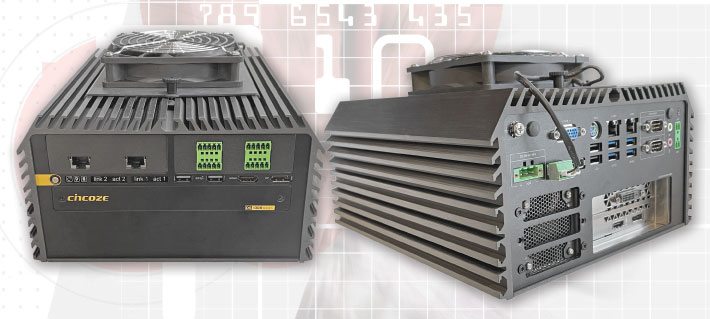
Cincoze calls their DS-1302 a high-performance expandable and modular rugged embedded computer and points at the system's wealth of modular customization options as a differentiating strategic advantage over competing products. The DS-1302 can be equipped with a range of socket-type Intel Xeon or Core CPUs for use in numerous high-end computing deployments. Its two PCI/PCIe expansion slots allow interfacing with all kinds of application-specific add-on cards. The machine is built to last in demanding environments, with rugged features including wide operating temperature and DC power input range, shock and vibration tolerance, and adherence to stringent ruggedness military and industrial standards.
Uses of high-performance fanless embedded PCs
Like the generic general purpose desktop computer, industrial embedded computer systems have an essentially limitless number of applications. Like standard desktop PCs, their BIOS and system boards are configurable in numerous ways. Unlike standard PCs, embedded computers are built to operate within wider temperature ranges and to be able to handle shock, vibration and numerous industry-specific hazards. Embedded systems generally don't require fans, using passive cooling instead. The Cincoze DS-1300 Series represents an advanced state-of-the-art implementation of a modern embedded system, one that supports a wider range of I/O and expansion than most in a package still compact enough to fit almost anywhere. Here are three examples of target markets for this sort of machine:
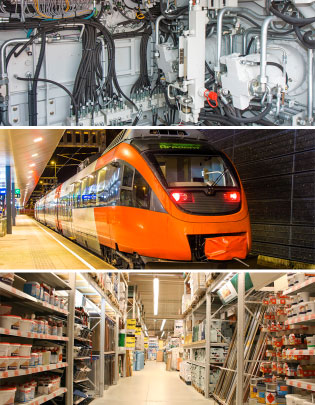
- Industrial automation — With the advent of Industry 4.0, smart factories are self-contained, utilizing automated production processes and inter-machine communication to enhance enterprise strategies and decision-making. Reliable high-performance industrial embedded computers, in addition to visual data acquisition, processing and analysis, play a vital role in optimizing production capacity and improving market competitiveness.
- Rolling stock — Rail transportation — including commuter rail, rapid transit, subways and light rail — requires continuous software and hardware upgrades to keep pace with increased security monitoring and passenger services needs. Advanced technology helps improve system safety, stability, and decision-making efficiency. Advanced technology also benefits road transportation as integration of sensors, GPS and real-time wireless transmission improves traffic monitoring, service, efficiency, and safety.
- Warehousing and logistics — Smart warehouses rely on sensors, RFID, network communication, GPS and automated logistics equipment for automatic capture, identification, early warning, and management of incoming and outgoing data. These smart systems reduce storage costs, optimize efficiency, and enhance management capabilities. Embedded computers are the brain of smart equipment, providing computation, control, and decision-making in smart storage solutions.
Looking at the Cincoze DS-1302
The image below shows the Cincoze DS-1302 from the top and all four sides. While the company's GP-3000 we recently reviewed had a basic system unit and different expansion units for customization, each DS-1300 Series model has a different height body. Like most industrial embedded systems, the housing consists of a aluminum chassis with face plates painted black, and a massive finned aluminum heat sink/spreader.
The DS-1300 Series is inherently designed for fanless operation. However, unlike fixed, non-expandable systems with known thermal loads, DS-1300 Series systems can be configured with such a wide variety of processors and an almost infinite number of possible expansion cards and modules that provision is made for additional active cooling. Our review unit came with the highest performance Intel Xeon processor option available for the series, as well as a powerful discrete NVIDIA GeForce GTX 1650 graphics card. That meant a big booster fan on top of the heatsink as well as an internal fan and the two fans that are part of the GTX 1650 card.
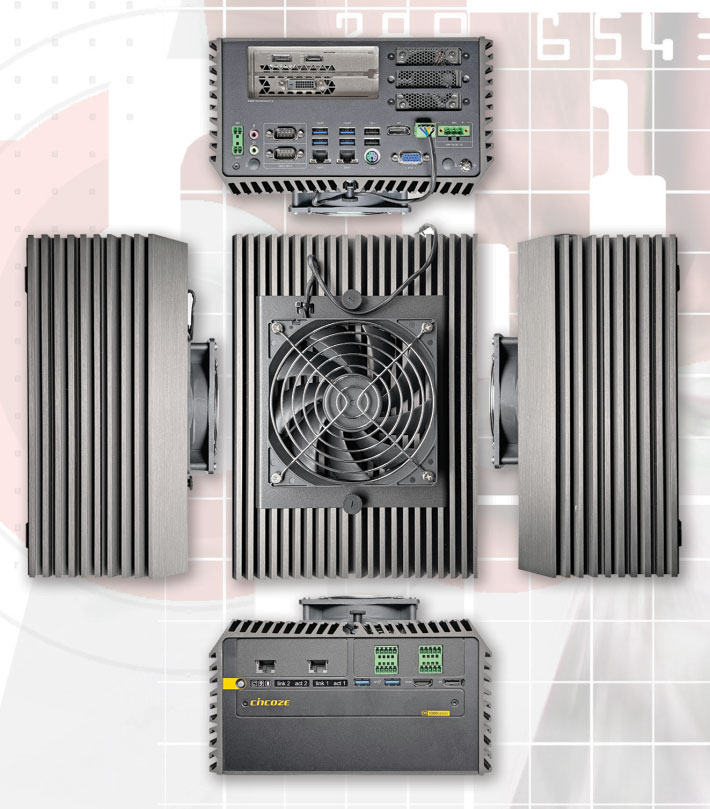
The Cincoze DS-1302, like almost all industrial and box PCs, is a simple and straight-forward design from the outside. It is a precision-engineered piece of computing machinery of very high quality. The design is rational and intelligent down to the smallest detail. Created to provide pretty much whatever I/O a customer needs as well as dual compact (up to 4.3 x 9.3 inch) PCI or PCIe-based expansion cards, the DS-1302 has a total power budget of 180 watts, supports a wide range of DC power input from 9 to 48 Volt, and can make available up to 110 watts to PCI/PCIe slots.
The picture below shows the system from the back where much of its I/O ports reside:
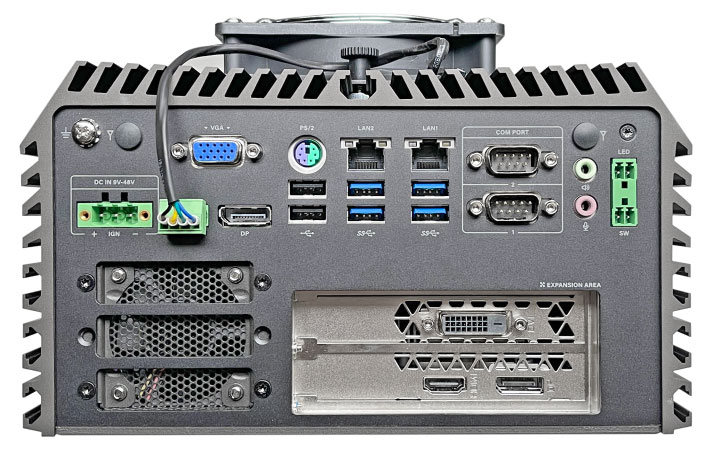
Unlike with panel PCs that often have all of their I/O facing down on the backside of the unit, box PCs generally have I/O both on the front and on the back. Our review Cincoze DS-1302 provided the following external ports on the back:
- 1 x VGA (1920 x 1200 @60Hz )
- 1 x Legacy PS/2
- 2 x RJ45 GbE LAN (GbE 1: Intel I219; GbE 2: Intel I210)
- 2 x DB9 RS-232/422/485 with Auto Flow Control (supports 5V/12V)
- 1 x Audio Line-out 3.5mm
- 1 x Audio Mic-in 3.5mm
- 1 x Remote power LED
- 1 x Remote On/Off
- 4 x 5Gbps USB 3.2 Gen1 Type A
- 2 x 480Mbps USB 2.0 Type A
- 1 x DisplayPort (4096 x 2340 @60Hz)
- 1 x DC power-in and ignition
- 1 x External fan power
- 2 x Antenna pass-through
- 2 x PCI/PCIe expansion cut-out
- 3 x Universal I/O brackets
Below is the view from the front. Here you find the power button, some indicator LEDs, additional I/O, and cutouts for the ports of various available expansion modules.
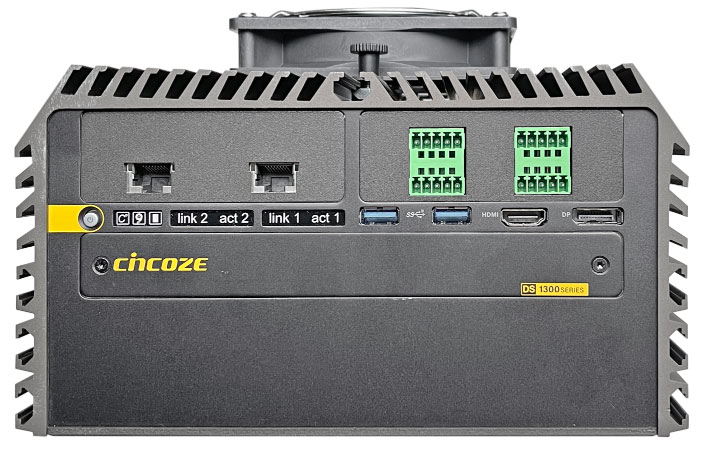
Standard front I/O consists of:
- 1 x DisplayPort (4096 x 2340 @60Hz)
- 1 x HDMI (4096 x 2160 @30Hz)
- 2 x 10Gbps USB 3.2 Gen2 Type A
- 1 x ATX power on/off button
Along the top are two expansion area for optional CMI modules, just like the universal I/O bracket area in the back of the machine can accommodate a variety of optional MEC modules. The versatility and customization potential of the Cincoze DS-1300 Series, in fact, lies in the numerous Cincoze CMI, CFM and MEC modular expansions and customization modules.
CMI modules — CMI stands for Combined Multiple I/O and is a proprietary Cincoze interface. Our review DS-1302 came with one CMI module that added two additional RJ45 10GbE LAN ports, and another that added 16 DIO lines (8in/8out). Available CMI modules for the DS-1302 provide:
- 4 x GbE LAN with RJ45 jacks
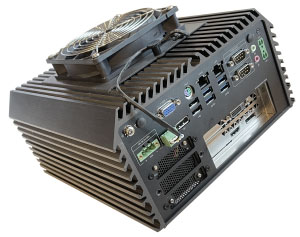
- 2 x 10GbE LAN with RJ45 jacks
- 4 x GbE LAN with M12 connectors
- 4 x GbE LAN with M12 X-coded connectors
- 4 x isolated RS232 with 5V/12V support and DB9 connectors
- 4 x isolated RS232/422/485 with 5V/12V support and DB9 connectors
- 16 x DIO (8DI, 8DO)
CFM modules — CFM stands for Control Function Module and is also a proprietary Cincoze technology that adds functionality via specific CFM boards. Generically, CFM Technology allows the support of PoE and IGN function for various applications.
The CFM module for the DS-1302 provides:
- A power ignition sensing module with delay time management and selectable 12V/24V voltage
- A PoE (Power over Ethernet) module, individual port 25.5W
MEC technology — MEC stands for mPCIe Card. This is a non-proprietary design. The DS-1302 can accommodate up to three such modules. Here, currently available modules are:
- 2 x RS232
- 2 x 5Gbps USB 3.2 Gen1, Type A
- 2 x GbE LAN, RJ45
The term "proprietary" can cause concerns of being locked in or not being compatible with industry standards. That's not an issue with the various Cincoze technologies; they are simply efficient conduits for industry-standard connectivity.
As we've come to expect from Cincoze, while their products may largely be geared towards industrial customers,  that never comes at the cost of attractive design and an ergonomic user interface. An example is the DS-1302's power and a temperature warning LED indicator light with various colors for system temperatur levels, lights for disk and GPIO activity, and then the activity of the two primary Ethernet lines.
that never comes at the cost of attractive design and an ergonomic user interface. An example is the DS-1302's power and a temperature warning LED indicator light with various colors for system temperatur levels, lights for disk and GPIO activity, and then the activity of the two primary Ethernet lines.
Concept and insides of the DS-1300 Series
Whereas the big Cincoze GP-3000 GPU computer we recently reviewed had a modular design that used a base unit and different size extension housings, the DS-1300 Series uses a different modular concept. 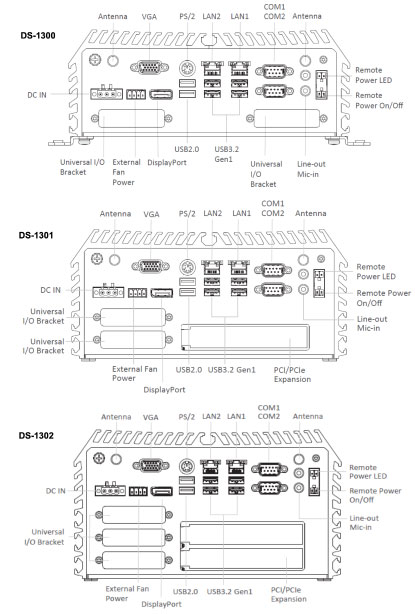 While the motherboard and standard I/O configuration stays the same in all currently available models, expansion is accommodated by making the entire housing, including the massive external heatsink, taller.
While the motherboard and standard I/O configuration stays the same in all currently available models, expansion is accommodated by making the entire housing, including the massive external heatsink, taller.
While all units have the same footprint, the basic DS-1300 is 3.46 inches tall, the DS-1301 4.25 inches, and the DS-1302 5.03 inches. That means a different chassis and a different heat sink. The incremental height is used to accommodate either one or two PCI/PCIe expansion slots on a riser card that plugs into the system board.
The illustration to the right shows the three currently available DS-1300 models. Each is a different height to accommodate internal expansion as well as the port cutouts for those expansions.
There are pros and cons to a modular system that requires entirely different housings rather than just bolting expansion boxes onto a base unit.
Among the advantages are a more cohesive look, more structural stability and — crucial in fanless systems — the presence of adequate additional cooling through the larger and heavier finned heatsink.
Disadvantages may include the need to stock three different size units rather than just base units and the anticipated number of expansion boxes.
Below you can see the Cincoze DS-1302 opened up. That's simple but, the first time you do it, you need to figure out how the design fits together and comes apart. As is, first the flat bottom plate, held in place with six small screws, is removed. Then you undo a couple of face plate screws. If no expansions are installed, it's then a simple matter of loosening the screws of four latches that very cleverly secure the entire chassis and all electronics in place. The way it works is that the latches have corresponding grooves in the heat sink. Excellent idea. Once the latches are retracted, the whole chassis simply lifts out. It is a bit more complex when expansion cards are installed and we'll get to that.
Note the light blue and light red rectangles. Those are the thermal conductive silicone rubber pads that conduct heat away from the processor and other electronics to the finned external heat sink. The pads are reusable as long as they remain in good condition upon removal of the heat sink.
And note, of course, that this is not just your average basic heat sink. It actually reveals one of the many secrets of the Cincoze DS-1302: the heat sink is more than the common extruded aluminum affair; it has copper heat piping integrated in it, optimizing cooling. Just like in some CPU configurations there is that big bolt-on fan pulling cool air through the external fins to increase cooling. The DS-1300 Series is inherently a fanless design but it is modular, too — if more cooling is needed, it becomes a powerful hybrid active/passive thermal cooling solution.
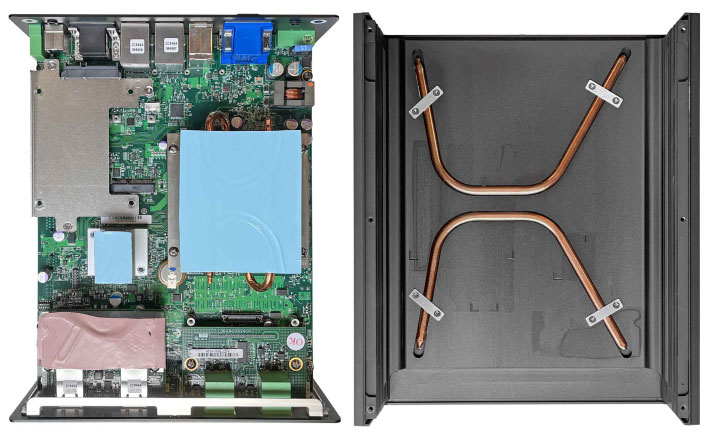
Looking onto the top side of the DS-1302's motherboard (shown below), it's a thing of beauty. On the left are the two CMI expansion modules. On the right a aluminum platform to mount a 2-1/2-inch SATA disk on. In the cutout of that base sits one of the unit's mini PCIe sockets.
The three massive aluminum heat sinks that both cool and conduct heat away from electronics and into the massive external finned heat sink represent superior industrial design, milled as they are from solid blocks of aluminum. Then there are the copper heat pipes in the CPU heatsink. Too bad these beautifully machined components are hidden away and not visible to the eye!
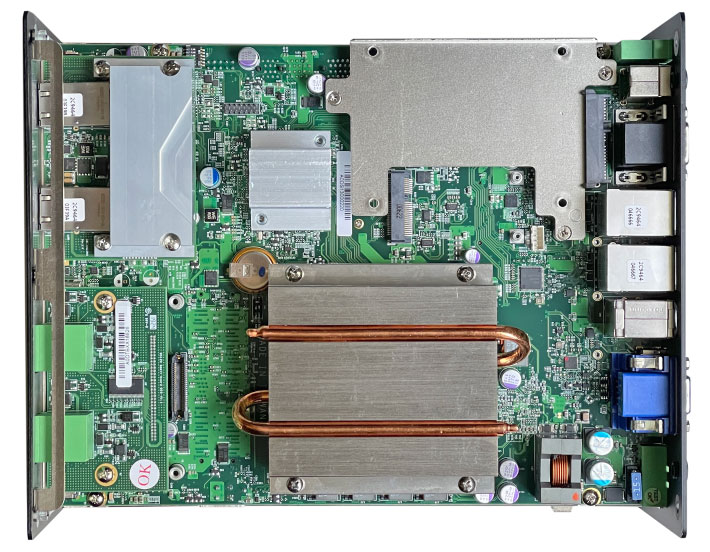
Below to the right is a look into the bottom of the chassis with the graphics card and some of the mounting mechanisms still in place. Note the small fan mounted onto the cutouts reserved for up to three MEC expansions. Our review unit didn't have any of those, and so the space was used to place a fan to augment active cooling of the installed NVIDIA graphics card.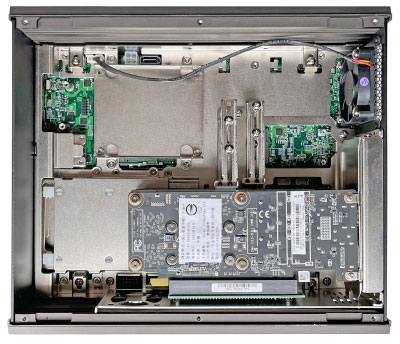
On the lower left is the aluminum-enclosed bay for an externally accessible 2-1/2 inch SATA hard or solid state disk.
Below is an enlarged look at the bottom of the chassis with the NVIDIA graphics card and some other mounting hardware removed. Now you can see the unit's dual SO-DIMM RAM sockets. Our sample came with 3200 MHz Cervoz DDR4 memory that Cincoze says improves performance considerably compared to the slower RAM used in its older Intel 9th generation-based units.
The two cutouts on the right of the chassis show two additional empty Mini-PCIe card sockets. Below those is the unit's M.2 Key M connector for a PCIe NVMe SSD, in our unit a Cervoz 512GB model with its own heat sink.
Below that is the PCI/PCIe riser card that, for the DS-1302, comes in four different versions:
- 2 x PCIe x8 slots
- 1 x PCIe x16 and 1 x PCI ex1
- 1 x PCIe x16 and 1 x PCI
- 2 x PCI slots
Add-on cards can be up to 110 x 237 mm and draw a combined 110 watts.
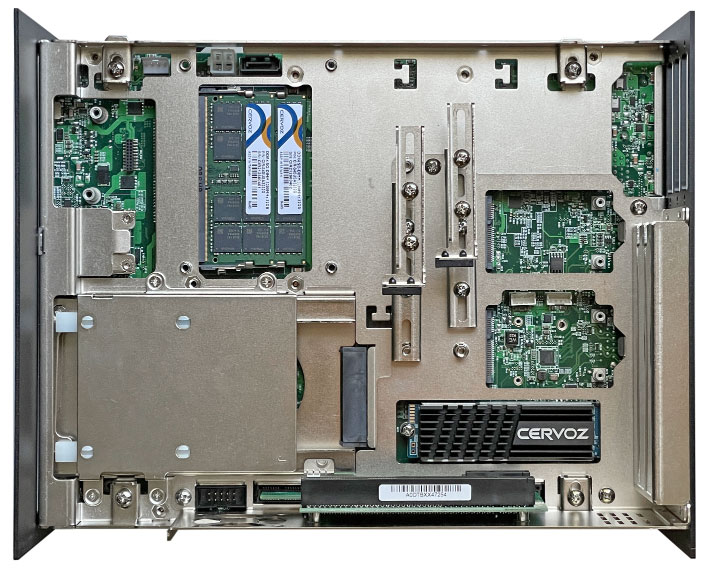
The case for additional graphics power
Those unfamiliar with GPU computers and the performance requirements of advanced graphics applications may wonder why a manufacturer goes to such lengths and expense to create a rugged embedded computer that can accommodate a separate add-on graphics card. The graphics built into Intel chips have become quite powerful, and the DS-1302 all by itself supports three independent displays via its own HDMI, VGA, and two DisplayPort connectors, all except the VGA port capable of 4K resolution. What embedded computer would need more? The answer is that while web browsing, business graphics, watching videos and even some gaming can easily be handled by the graphics built into modern processors such as the ones available for the DS-1302, there are many imaging applications that need higher GPU performance than is available from the graphics built into Intel chips.
The question then becomes how much more. The Cincoze GP-3000 GPU computer we reviewed a few months ago was built to accommodate high-end graphics cards such as the Nvidia GeForce RTX 3090 capable of extremely high Open CL performance (Open CL is a programming language used to exploit the full performance of graphics cards for advanced applications).
That is not what Cincoze was after with the DS-1302. The goal here was to create a compact system that could accommodate PCI/PCIe expansion cards including those that add affordable graphics performance well above integrated graphics. And a low-profile card using NVIDIA's GeForce GTX 1650 is such a system. It adds considerable graphics punch, albeit not nearly as much as the monster GeForce RTX 3090 in the Cincoze GP-3000 GPU computer. But GTX 1650 cards cost much less than RTX 3090 cards, need far less power, and generate far less heat and noise. The picture below shows just how small and compact the NVIDIA GeForce GTX 1650-based Zotec card is.
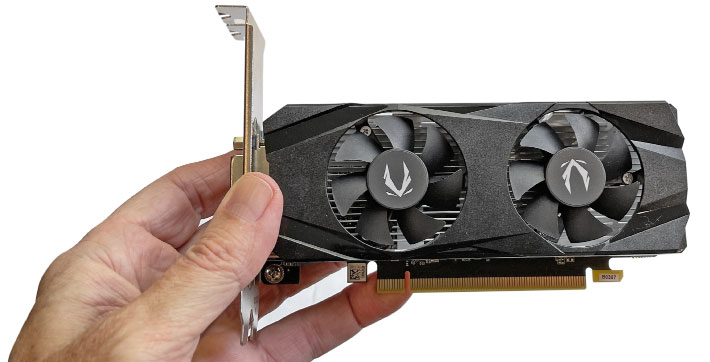
Is a low profile graphics card the answer for everyone? No. If leading-edge graphics performance is required, small form factor cards may not do. But if they are fast enough for a given job and can handle specific graphics requirements, they're a great deal. In addition to Zotec, MSI, Gigabyte, Asus, EVGA and several others all have low-profile cards in various configurations and using different GPU architectures that all work with the DS-1302.
What kind of performance improvements can you expect from adding a low-profile graphics card to an embedded system like the DS-1302? That depends on system configuration, the type of graphics card, and the application. We did some benchmark testing with and without the discrete graphics card installed. The results varied greatly, ranging from a massive a 650% improvement in Open CL performance, nearly the same improvement in the 3DMark Time Spy benchmark, and overall 25% improvement in PCMark 10, to very little different in PassMark 6.1 and CrystalMark. What it boils down to is matching the capabilities and strong sides of an add-on card to the task at hand.
The image below shows another one of those special touches we've come to expect from Cincoze computers. It's a clever PCI/PCIe card patent-pending retainer system. Both retainers are adjustable to firmly secure cards into their slots. That provides extra protection from cards shaking loose due to vibration or shocks on the job in vehicles or other rolling stock.
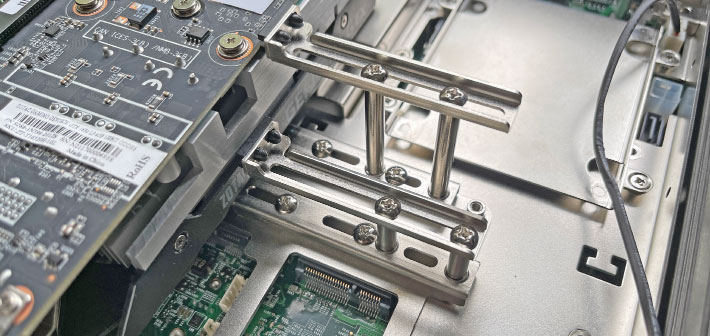
Thermal considerations
According to the second law of thermodynamics, heat flows from warmer places to colder ones in an attempt to equalize the temperature difference, similar to higher water levels flowing to lower ones in an effort to have a qual surface elevation.
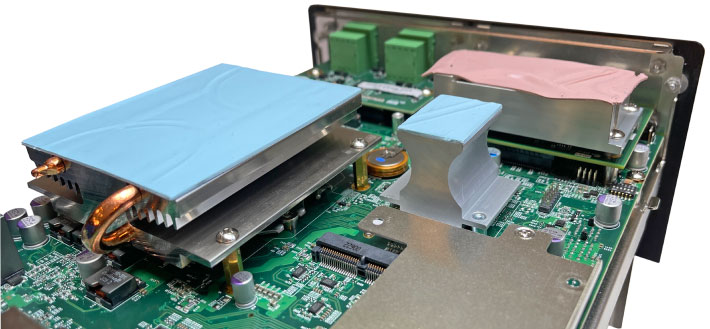
Almost all materials conduct heat, albeit to greatly varying degrees. Thermal conductivity is measured in watts per square meter of surface area for a temperature gradient of one degree Kelvin through a distance one meter.
When it comes to heat sinks and heat pipes in computers, the materials used are generally aluminum and copper. Copper offers about 70% higher thermal conductivity than aluminum, but costs about three times as much weighs more than three times as much.
As a result, in computers copper is primarily used for heat pipes guiding heat away from CPUs and other heat generating electronics. Copper is also used for small thermal conducting plates and such. Aluminum, on the other hand, is frequently used to dissipate heat on the outside of industrial computers, with heavily finned surfaces creating as much heat-dissipating surface as possible.
So both materials have their place, but by and large, systems designers use either one or the other. Cincoze, however, decided to use both, taking advantage of the special properties of each metal.
In the DS-1302, Cincoze created a hybrid copper/aluminum design where both the CPU heat sink as well as the primary external fanned heat sink and dissipator use both metals. The copper pipes secured into grooves in the actively air-cooled aluminum finned heat sink spread heat faster than aluminum. This way, more heat gets removed faster.
This results in an elaborate, intelligent and nicely executed solution. It'd be overkill if the DS-1300 were a one-size-fits-all type of system with predictable heat loads. But that's not the case here; the Series is highly configurable and scaleable. A DS-1300 system equipped with one of the lesser available CPUs with TDPs as low as 35 watts runs cool even at full speed all day without any fans at all. But the DS-1300 Series was designed for scaleable performance with much hotter running CPUs and hot-running expansions. So Cincoze designed it to stay cool no matter what.
The thermal images below were taken with our FLIR One Pro camera. It shows our review DS-1302 in the midst of running one of the many benchmarks we subjected it to. As you can see, equipped with the Nvidia GeForce GTX 1650 card, exhaust and surface temperatures didn't even reach 80F.
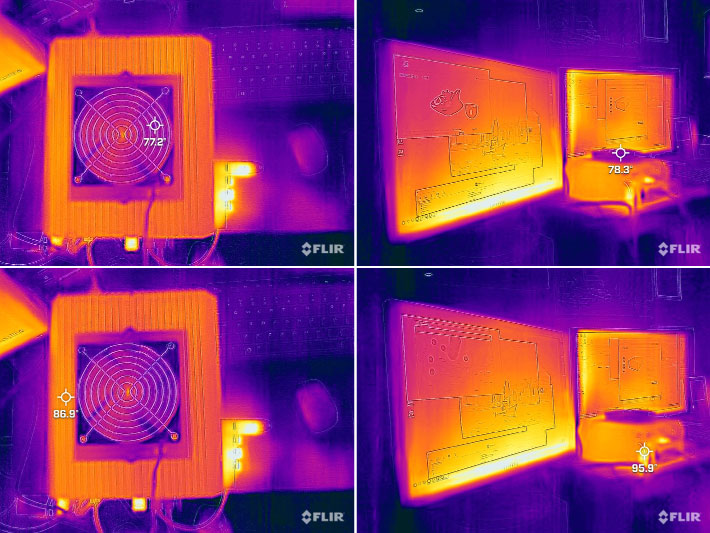
Massive performance
When Cincoze approached RuggedPCReview about hands-on with their new DS-1302, they inquired as to what configuration we'd like to test. We asked for the fastest, meanest, no-holds barred configuration possible. Cincoze came through, and our review DS-1302 arrived with an Intel Xeon W-1270E octa-core workstation-class processor with a base clock speed of 3.40GHz, a maximum turbo speed of 4.80GHz and a desktop/workstation-class 80 watt Thermal Design Power. And the system came with a low-profile Nvidia GeForce GTX 1650-powered discrete GPU card.
To provide an idea of the relative performance of the so-equipped Cincoze DS-1302, we ran not only our traditional standard benchmark suites — PassMark (both versions 6.1 and 9.0) and CrystalMark — but also PC Mark 10, GeekBench 5 and 3DMark, and listed not just the overall results but also some specific graphics benchmarks. For comparison, we added benchmark data of the Cincoze GP-3000 with its big Geforce RTX 3090 card we recently tested, and the Cincoze GM-1000, also a GPU industrial box that we reviewed last year.
We also wanted to show where the Cincoze DS-1302 stood compared to the highest level of performance you can get in 2021 from rugged laptops equipped with high-end Intel 10th and 11th generation Core processors. We're not naming those reference systems as they are not directly in competition with industrial GPU computers; they are just here for reference.
|
Cincoze DS-1302 Benchmarks and Comparisons
|
|
|
Cincoze
|
Cincoze
|
Cincoze
|
Comparison A
|
Comparison B
|
|
Model
|
DS-1302
|
GP-3000
|
GM-1000
|
High-end 10th gen
|
High-end 11th gen
|
|
|
|
|
|
|
|
|
Year tested
|
2021
|
2021
|
2020
|
2021
|
2021
|
|
Intel processor
|
Xeon W-1270E
|
Xeon E-2278GEL
|
Core i7-9700TE
|
Core i7-10710U
|
Core i7-1185G7
|
|
Cores/threads
|
8/16
|
8/16
|
8/8
|
6/12
|
4/8
|
|
CPU base speed
|
3.40GHz
|
3.30GHz
|
1.80GHz
|
1.10GHz
|
NA
|
|
CPU turbo speed
|
4.80GHz
|
4.70GHz
|
3.80GHz
|
4.70GHz
|
4.8GHz
|
|
Thermal Design Power (TDP)
|
80.0 watts
|
80.0 watts
|
35.0 watts
|
15.0 watts
|
12/28.0 watts
|
|
GPU
|
GeForce GTX 1650
|
GeForce RTX 3090
|
Intel UHD Graphics 630
|
GeForce GTX 1050
|
Intel Iris Xe Graphics
|
|
Overall PassMark 6.1
|
10,580.2
|
9,197.0
|
6,601.1
|
6,430.2
|
8,292.7
|
|
Overall PassMark 9.0
|
7,224.0
|
6,856.2
|
4,096.0
|
4,531.8
|
5,637.2
|
|
PassMark 9.0 3D
|
9,376.0
|
15,590.5
|
1,163.2
|
3,026.3
|
3,669.6
|
|
Overall CrystalMark
|
523,970
|
476,982
|
362,403
|
333,057
|
488,622
|
|
CrystalMark OGL
|
45,246
|
43,308
|
12,503
|
35,296
|
15,320
|
|
Overall PC Mark 10
|
6,187
|
6,519
|
NA
|
4,265
|
4,876
|
|
GeekBench 5 Single Core
|
1,262
|
1,155
|
NA
|
1,238
|
1,545
|
|
GeekBench 5 Multi Core
|
8,315
|
6,154
|
NA
|
4,187
|
5,225
|
|
GeekBench 5 Open CL
|
39,398
|
188,649
|
NA
|
NA
|
16,653
|
|
3D Mark TimeSpy
|
3,865
|
15,563
|
NA
|
1,520
|
1,579
|
The results show four things:
- First, equipped with an Intel Xeon W-1270E octa-core processor and a dedicated graphics card such as the Nvidia GTX 1650, the Cincoze DS-1302 performs at an overall higher level than even the highest-end rugged mobile laptop or tablet systems.
- Second, equipped this way, graphics performance can be significantly higher than even what is available with the discrete GPUs optionally available in mobile systems — albeit not as high as a truly top-of-the-line, full-size GPU cards such as the Nvidia GTX 3090 we tested in the Cincoze GP-3000.
- Third, given the very large number of CPU options Cincoze offers for the DS-1302 computer platform, customers should test for themselves how various CPU/GPU combinations perform.
- And forth, don't forget that overall system performance depends on the performance of all components. Even with the highest-end graphics cards systems will benefit from also having the fastest available PCIe NVMe storage.
The graph below shows the DS-1302's CPU and GPU clock frequencies as the system powered through the demanding 3DMark Time Spy benchmark. And it shows one of the secrets of the DS-1302's excellent performance: Thanks to its highly effective cooling, the system isn't reducing clock speeds while running the benchmark. It powers right through at full speed. High-performance processors are very sensitive to overheating and therefore use a battery of sensors throughout the system. If things get too hot, as they will at high load, the processor throttles down. Only effective thermal management can keep clock frequencies high, and the DS-1302 apparently can do that.
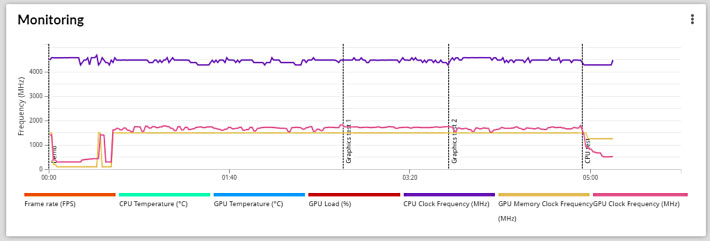
Vast choice of processors
To help with the CPU decision, peruse the table below. It shows all the different Intel 10th generation XEON processors available for the Cincoze DS-1302:
|
Cincoze DS-1302 Intel 10th Generation "Comet Lake" XEON processor options
|
|
PROCESSOR OPTIONS
|
W1270E
|
W1250E
|
W1290TE
|
W1270TE
|
W1250TE
|
|
Cores/Threads
|
8/16
|
6/12
|
6/12
|
8/16
|
6/12
|
|
Base Clock Speed
|
3.40 GHz
|
3.50 GHz
|
1.80 GHz
|
2.00 GHz
|
2.40 GHz
|
|
Turbo Speed
|
4.80 GHz
|
4.70 GHz
|
4.50 GHz
|
4.40 GHz
|
3.80 GHz
|
|
Cache
|
16MB SmartCache
|
12MB SmartCache
|
20MB SmartCache
|
16MB SmartCache
|
12MB SmartCache
|
|
Thermal Design Power (TDP)
|
80 watts
|
80 watts
|
35 watts
|
35 watts
|
35 watts
|
|
Graphics base speed
|
350 MHz
|
350 MHz
|
350 MHz
|
350 MHz
|
350 MHz
|
|
Graphics max speed
|
1.20 GHz
|
1.20 GHz
|
1.20 GHz
|
1.15 GHz
|
1.15 GHz
|
|
Intel vPro
|
Yes
|
Yes
|
Yes
|
Yes
|
Yes
|
|
Intel TSX
|
Yes
|
Yes
|
Yes
|
Yes
|
Yes
|
|
Intel Trusted Execution
|
Yes
|
Yes
|
Yes
|
Yes
|
Yes
|
The Cincoze DS-1302 is also available with eight different Intel "Comet Lake" 10th generation CORE processors:
|
Cincoze DS-1302 Intel 10th Gen "Comet Lake" CORE processor options
|
|
PROCESSOR OPTIONS
|
Core i9
|
Core i7
|
Core i5
|
Core i3
|
Core i9
|
Core i7
|
Core i5
|
Core i3
|
|
Model
|
10900E
|
10700E
|
10500E
|
10100E
|
10900TE
|
10700TE
|
10500TE
|
10100TE
|
|
Cores/Threads
|
10/20
|
8/16
|
6/12
|
4/8
|
10/20
|
8/16
|
6/12
|
4/8
|
|
Base Clock Speed
|
2.80 GHz
|
2.90 GHz
|
3.10 GHz
|
3.20 GHz
|
1.80 GHz
|
2.00 GHz
|
2.30 GHz
|
2.30 GHz
|
|
Turbo Speed
|
4.70 GHz
|
4.50 GHz
|
4.20 GHz
|
3.80 GHz
|
4.50 GHz
|
4.40 GHz
|
3.70 GHz
|
3.60 GHz
|
|
Cache
|
20MB SmartCache
|
16MB SmartCache
|
12MB SmartCache
|
6MB SmartCache
|
20MB SmartCache
|
16MB SmartCache
|
12MB SmartCache
|
6MB SmartCache
|
|
Thermal Design Power (TDP)
|
65 watts
|
65 watts
|
65 watts
|
65 watts
|
35 watts
|
35 watts
|
35 watts
|
35 watts
|
|
Graphics base speed
|
350 MHz
|
350 MHz
|
350 MHz
|
350 MHz
|
350 MHz
|
350 MHz
|
350 MHz
|
350 MHz
|
|
Graphics max speed
|
1.20 GHz
|
1.15 GHz
|
1.15 GHz
|
1.10 GHz
|
1.20 GHz
|
1.15 GHz
|
1.15 GHz
|
1.10 GHz
|
|
Intel vPro
|
Yes
|
Yes
|
Yes
|
No
|
Yes
|
Yes
|
Yes
|
No
|
|
Intel TSX
|
Yes
|
Yes
|
Yes
|
No
|
Yes
|
Yes
|
Yes
|
No
|
|
Intel Trusted Execution
|
Yes
|
Yes
|
Yes
|
No
|
Yes
|
Yes
|
Yes
|
No
|
What may make a difference in certain applications is the availability of four special Intel technologies (vPro, TSX-NI, SIPP, and Trusted Execution) included in some of the available processors but not in others. Here's what that means:
The extra security and manageability capabilities of vPro, especially, are required in many enterprise deployments.
- TSX-NI (Transactional Synchronization Extensions New Instructions) helps make parallel operations more efficient via improved control of locks in software,
- Trusted Execution technology provides security capabilities such as measured launch and protected execution, and may thus also be an enterprise requirement.
Note that in our table above we only listed the DS-1302's available Intel "Comet Lake" 10th generation XEON and CORE processor options. Also available are a number of economical Pentium and Celeron G-Series versions.
Ruggedness
From a ruggedness standpoint, embedded industrial PCs such as the Cincoze DS-1302 may encounter temperatures extremes, shock/vibration, and airborne particulates. Since embedded systems are not carried around, the drop spec and IP rating (sealing against solids and liquids) that in part define the durability of mobile devices are essentially irrelevant. Shock and vibration resistance, however, are not, and those have been tested to MIL-STD-810G procedures.

The operating temperature range can be as wide as -40°F to 158°F with a low-end 35 watt TDP CPU, and varies depending on processor and GPU options. The upper operating temperature limit drops to 122°F with a 58-65 watt TDP processor even with the external fan kit. And systems using an 80 watt TDP processors shouldn't be operating in temperatures beyond 104F even with the external fan.
The Cincoze DS-1302 also passed the stringent MIL-STD-810G military standard shock and vibration resistance tests that the US Department of Defense uses to qualify military equipment.
Overall, Cincoze observed proper rugged design principles for this type and class of machine, including the unibody chassis, cable- and jumper-less design as well as integrated anti-vibration measures. They also sought to comply with all pertaining EN 50121-3-2 (EN 50155) rolling stock, and EN62368-1 safety rolling stock standards to ensure stable and reliable performance of the unit. That also includes medical-grade ESD and interference protection, solid-state components as well as wide 9-48VDC input voltage support.
Ruggedness also requires secure mounting methods. Here, the Cincoze DS-1302 offers a wall-mount kit that looks like it could also be used for other mounting locations.
There's a remote power on/off and remote reset function, optional power ignition sensing with delay time management, reverse power input protection, ESD and surge protection, over-current and over-voltage protection, and a super capacitor so that there won't ever be issue with a dying CMOS battery.
Faster storage
On the mass storage side, the Cincoze DS-1302 is ahead of much of the embedded systems competition. That's because it makes available PCIe NVMe instead of, or in addition to, older, slower SATA-based storage technology. To explain the advantage of that we must backtrack a little. For decades, hard disks served as mass storage almost exclusively. Hard disks are complex mechanical devices with rotating platters and fragile read heads. Wear and tear is an issue with hard disks, as are disk crashes due to vibration or impact. 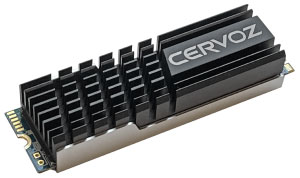 For that reason, hard disks have mostly been replaced by faster and less vulnerable SSDs — solid state drives — in most applications.
For that reason, hard disks have mostly been replaced by faster and less vulnerable SSDs — solid state drives — in most applications.
However, even SSDs have their bottlenecks. In terms of performance, for some time now that bottleneck has been the SATA interface between the storage module and the computer. SATA's been around for a decade and a half and its data transmission speed has pretty much maxed out.
The PCIe standard, on the other hand, can reach throughput speeds up to several times higher, depending on which PCIe standard is used and how many "lanes" are available. And PCIe doesn't even require major changes. The standard M.2 connector supports both SATA and PCIe, and PCIe storage modules are the same "gumstick" size as SATA storage modules. And that was what was in our review DS-1302, a very fast industrial Cervoz M.2 2280 T435 NVMe PCIe Gen3 x 4 Embedded Module with integrated heat sink (see here).
The Cincoze DS-1302
With the DS-1300 Series, Cincoze offers a modular and highly scalable rugged industrial embedded computer platform that, as of this review, comes in three different models. We tested the DS-1302 version that provides an impressive degree of expansion and customization as well as room for two PCI/PCIe expansion slot-mounted cards. Designed for applications in industrial automation, warehousing and logistics, rolling stock and other areas, the DS-1302 can be configured with your choice of almost 20 different Intel 10th generation Xeon, Core, Pentium and Celeron processors as well as SATA and PCIe storage, modules and accessories.

The Cincoze DS-1302 offers plenty of onboard wired communication to fit just about any application, augmented by combined multiple I/O interface options as well as ignition sensing for vehicular applications. There is room for plenty of storage, ranging from dual 2.5-inch SATA HDDs or SDDs with RAID 0/1/5/10 support to an M.2 socket for high-speed NVMe SSDs. Thanks to its support for low-profile GPU cards in a compact package, the DS-1302 is suitable for any number of applications that not only need high-end processing power, but also more GPU performance than integrated graphics can provide. Impressive as well is the superb product documentation and the very detailed product manual.
-- Conrad H. Blickenstorfer, October 2021
|
Cincoze DS-1302 Specifications
|
| Status |
Added and reviewed 10/2021
|
| Type |
High-performance industrial AI and Machine Vision GPU computer
|
| CPU Type |
Intel® Xeon Series Processor ( 80W / 35W ):
Intel® Xeon W-1270E 8 Cores Up to 4.8 GHz, TDP 80W
Intel® Xeon W-1250E 6 Cores Up to 4.7 GHz, TDP 80W
Intel® Xeon W-1290TE 10 Cores Up to 4.5 GHz, TDP 35W
Intel® Xeon W-1270TE 8 Cores Up to 4.4 GHz, TDP 35W
Intel® Xeon W-1250TE 6 Cores Up to 3.8 GHz, TDP 35W
Intel® Core Series Processor ( 65W / 35W ):
Intel® Core i9-10900E 10 Cores Up to 4.7 GHz, TDP 65W
Intel® Core i7-10700E 8 Cores Up to 4.5 GHz, TDP 65W
Intel® Core i5-10500E 6 Cores Up to 4.2 GHz, TDP 65W
Intel® Core i3-10100E 4 Cores Up to 3.8 GHz, TDP 65W
Intel® Core i9-10900TE 10 Cores Up to 4.5 GHz, TDP 35W
Intel® Core i7-10700TE 8 Cores Up to 4.5 GHz, TDP 35W
Intel® Core i5-10500TE 6 Cores Up to 3.7 GHz, TDP 35W
Intel® Core i3-10100TE 4 Cores Up to 3.6 GHz, TDP 35W
Intel® Pentium Series Processor ( 58W / 35W ):
Intel® Pentium G6400E 2 Cores Up to 3.8 GHz, TDP 58W
Intel® Pentium G6400TE 2 Cores Up to 3.2 GHz, TDP 35W
Intel® Celeron Series Processor ( 58W / 35W ):
Intel® Celeron G5900E 2 Cores Up to 3.2 GHz, TDP 58W
Intel® Celeron G5900TE 2 Cores Up to 3.0 GHz, TDP 35W
|
| Chipset |
Intel W480E
|
| Graphics |
Integrated Intel UHD Graphics (Xeon/i7/i5/i3: UHD 630; Pentium/Celeron: UHD 610)
|
| OS |
Windows 10, Linux
|
| Memory |
Xeon/i9/i7: up to 64GB 2933MHz in two DDR4 SO-DIMM sockets
Core i5/i3: up to 64GB 2666MHz in two DDR4 SO-DIMM
Pentium/Celeron: up to 64GB 2400MHz in two DDR4 SO-DIMM sockets
|
| Watchdog Timer |
Software programmable supports 256 levels, system reset |
| Graphics Interface |
Supports triple independent displays (VGA/DisplayPort/HDMI); exact configuration depends on options
|
| LAN |
1 x RJ45 GbE LAN (Intel I210), 1 x RJ45 GbE LAN (Intel I219); optional CMI modules with 4 x RJ45 GbE LAN OR 4 x M12 A-coded GbE LAN OR 2 x RJ45 10GbE LAN
|
| Expansion |
2 x PCI/PCIe expansion slot on optional riser card
3 x full-size Mini-PCIe
2 x SIM socket
2 x High-speed CMI Interface for optional CMI module
2 x Low-speed CMI Interface for optional CMI module
1 x CFM IGN interface for optional CFM-IGN module
|
| Primary Storage |
3 x mSATA socket (SATA 3.0, shared by Mini-PCIe socket )
1 x M.2 Key M Type 2280 socket for PCIe x4 NVMe SSD or SATA 3.0 SSD
System supports RAID 0 / 1 / 5 / 10
|
| Housing |
Aluminum chassis with finned and actively cooled aluminum heatsinks, copper heat piping; mounting options for wall mount, desktop mount
|
| Vibration |
Tested according to MIL-STD-810G
|
| Shock |
Tested according to MIL-STD-810G
|
| Humidity |
up to 95% relative humidity non-condensing
|
| Operating temperature |
35W TDP processors: -40°F to 158°F (-40°C to 70°C)
58W to 65W TDP processors: -40°F to 122°F (-40°C ~ 50°C) with external fan kit
80W TDP processors: -40°F to 104°F (-40°C ~ 40°C) with external fan kit
|
| USB |
2 x 10Gbps USB 3.2 Gen2, Type A
4 x 5Gbps USB 3.2 Gen1, Type A
2 x 480Mbps USB 2.0, Type A
|
| Serial |
2 x DB9 RS-232/422/485 with Auto Flow Control (supports 5V / 12V )
|
| Digital I/O |
Optional 16x DIO (8DI, 8DO) CMI module
|
| CAN Bus |
NA
|
| Audio |
Realtek ALC888 HD audio, 1 x Line-out, 1 x Mic-in |
| Size |
8.9 x 10.3 x 5.0 inches (227 x 261 x 128 mm)
|
| Weight |
11.9 lbs (8.0 kg) |
| Power |
Wide-input 9 to 48 VDC, dual 3-pin Terminal Block connectors with 180 watt total power budget; remote power/on/off, remote power LED
|
| Certifications |
EMC: CE/FCC, ICES-003 Class A, EN 50121-3-2; Safety: IEC/EN 62368-1
|
| Price |
Inquire |
| Webpage |
Cincoze DS-1302 page |
| Spec sheet |
Cincoze DS-1302 data sheet |




